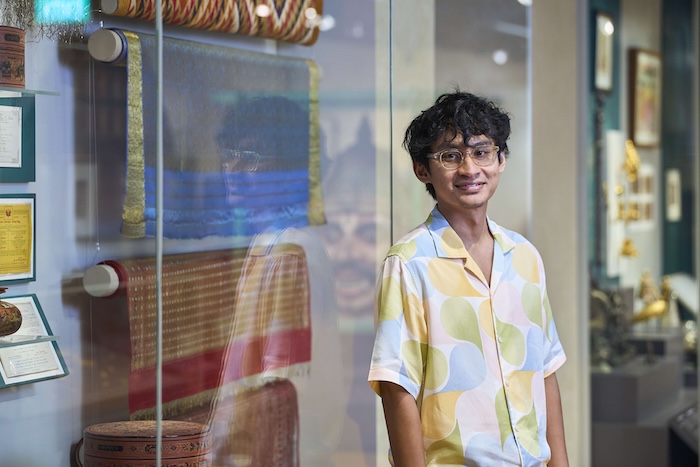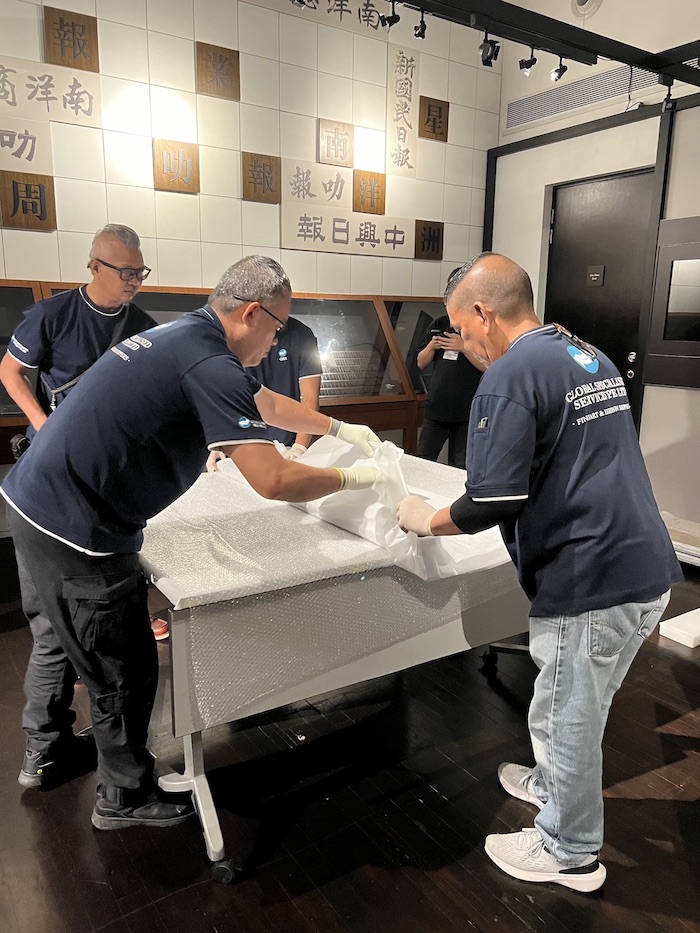TL;DR
What’s it like to manage museum exhibitions? We interview Muhammad Noor Aliff Bin Ghani, Assistant Director (Collections & Exhibitions) at the National Heritage Board, to find out more about his work behind the scenes in bringing history to life for museum visitors.
MUSESG Volume 16 Issue 2 - July 2023
Read the full MUSE SG Vol 16, Issue 2.
Muhammad Noor Aliff Bin Ghani, an Assistant Director (Collections & Exhibitions) of Heritage Institutions at the National Heritage Board (NHB), manages the collections and exhibitions of the Malay Heritage Centre, Indian Heritage Centre, and Sun Yat Sen Nanyang Memorial Hall.
Aliff is responsible for the execution of special exhibitions. This entails managing exhibition schedules, developing exhibition designs, and dealing with conservation and display matters, to fabrication and site renovation, installation of artefacts and gallery maintenance.
The exhibitions he has produced include the Peranakan Museum’s Great Peranakans (2015), Asian Civilisations Museum’s (ACM) Angkor (2018), Malay Heritage Centre’s Cerita (2022) and Sun Yat Sen Nanyang Memorial Hall’s Connections Across Oceans (2023). He was also heavily involved in the refresh of ACM’s permanent galleries from 2015 to 2021 and the recent revamp of the Peranakan Museum. Currently, he is working on the Indian Heritage Centre’s upcoming special exhibition Ente Veedu, My Home: Malayalees in Singapore and the revamp of the Malay Heritage Centre’s galleries.
Aliff introduces MUSE SG to the behind-the-scenes world of producing an exhibition and walks us through the many steps that take place before its opening day.
Watch: Meet Collections & Exhibitions Manager Aliff
01. HI, ALIFF! PLEASE TELL US WHAT DREW YOU TO THIS FIELD.
Perhaps I can start by explaining how NHB entered my life. After graduating with a marketing management degree in 2010, I started an internship at NHB’s Facilities Marketing department. When my internship ended, I found a full-time position at the National Museum’s Philanthropy department where I helped raise funds for the museum by organising gala dinners and raising cash and in-kind sponsorships. I subsequently moved to ACM in the same role.
In 2014, there was an opening in ACM’s Exhibitions division and I thought to myself, ‘Why not?’ Of course, it would be a 180-degree change. As part of my job at the Philanthropy department, I was used to dressing smartly to attend events like high teas and dinners to pitch proposals to the museum’s donors. But I felt that time was ripe for a change; I was ready to ‘get my hands dirty’. Hence I switched to being an exhibitions manager, working together with curators and conservators to produce and organise exhibitions as well as set up galleries.
02. MANY OF US WOULD HAVE VISITED A MUSEUM EXHIBITION BEFORE, BUT FEW KNOW WHAT HAPPENS BEHIND THE SCENES. CAN YOU SHARE WITH US THE WORK YOU DO AS AN EXHIBITION MANAGER?
There is a great deal of planning that goes into an exhibition. This area of work requires technical knowledge, analytical planning and critical thinking skills as well as attention to the minutest of details. Curators provide the content and may have a display ‘wish list’. They may envision, for example, a particular piece of textile to be ‘floating’ vertically when displayed. I take this suggestion to the conservators to find out if such a mode of display is practical and can be executed, but more importantly whether It would damage the artefact. After discussing and brainstorming ideas with the exhibition designer, we advise curators on the most feasible and safest way to display the object. As a team, we try to give meaning to the display and contextualise it. This helps provide the best experience for audiences and enables them to fully appreciate the artefacts.
One example is the traditional Chinese Peranakan kitchen setting at the Peranakan Museum’s Ceramics Gallery. Typically, we display porcelainware such as the kamcheng (a type of covered porcelain jar), ornate glazed ceramic wall tiles and traditional kitchen implements like the batu giling (grindstone). But how can we integrate all these artefacts into a meaningful yet dynamic display? For example, can we show the kamcheng in such a way as if someone is opening its lid without compromising the integrity and safety of the artefact? In order to achieve the ideal result, we work with specialists such as the mounting team.
Also, one of the last touches for a display is lighting. As illumination can accentuate the features of an object and ‘bring it to life’, we study how to stage the artefact using directional lighting like spotlights and under-shelf lamps.
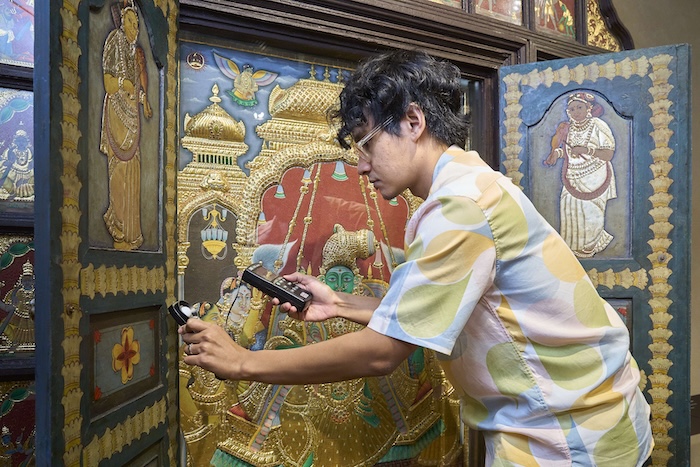
When producing an exhibition, I ensure accessibility by adhering to the principles of universal design—in other words, ‘design for all’. This means that the design of products, architecture and environments is attuned to the needs of as many people as possible, regardless of ability or age. The physically challenged, children and elderly, for example, should all be able to experience the exhibition with ease. For instance, showcases are set at a certain angle and height so that everyone can view them easily. Text size and font type used in the accompanying displays are also given significant consideration to ensure their legibility.
A key aspect of exhibition work is the care and maintenance of exhibits. Our work does not stop once an exhibition is launched. After the grand opening fanfare, the team carries out regular checks and maintenance of the artefacts, such as surface cleaning and preventive conservation work. I also ensure that other aspects of an exhibition run smoothly, such as security, climate environmental monitoring and light management. Gallery maintenance is usually scheduled on Mondays when the Heritage Institutions are closed to the public to minimise disruption to visitors.
Finally, another aspect of my work is collections management. We may at times have to borrow rare items from overseas and local institutions or lenders for an exhibition. In such cases, I oversee the entire loan process, including freight, logistics, insurance, legal paperwork, commissioning custom-made crates for the artefacts for transport, packing, courier management and so on. There are even occasions when supervision on the airport tarmac is required; staff will then have to ensure that artefacts are loaded or unloaded carefully onto the plane so that nothing is damaged while in transit.
03. CAN YOU TELL US MORE ABOUT THE MAINTENANCE AND CARE OF EXHIBITIONS?
There are many considerations when deciding how each artefact is to be displayed, depending on its size, material and fragility. One of the key elements in any exhibition is lighting. We have to ensure that the lighting is sufficiently bright for viewers. However, harsh light can also damage artefacts, particularly those made of paper and textiles. Materials may tarnish or pigments and ink may fade over time when inappropriate lighting is used. Therefore, we have to regularly check the displays with a lighting meter that provides readings for brightness and ultraviolet intensity.

Another crucial factor is the relative humidity in the display cases. The presence of moisture and fluctuations in humidity can wreak havoc on an artefact, causing paper to warp and materials like metals to degrade due to rust, corrosion and even mould. To cite a very relatable example: during Singapore’s partial lockdown at the height of the COVID-19 pandemic, shops selling leather goods like shoes and bags had to contend with mouldy stock when they reopened. The culprit was unstable humidity levels caused by the extended absence of air-conditioning in the closed shopping centers.
Humidity levels have to be kept in check in order to prolong the lifespan of our artefacts. Besides being airtight, each display case is equipped with a data logger that tracks the relative humidity and temperature of the microenvironment. We maintain the humidity level by using a moisture-sensitive silica material that absorbs moisture and condensation from the surrounding environment. Some artefacts are on open display, meaning they are not kept within glass cases, which makes them particularly prone to dust. For these artefacts, we surface-clean them regularly with a conservation-grade vacuum and brushes.
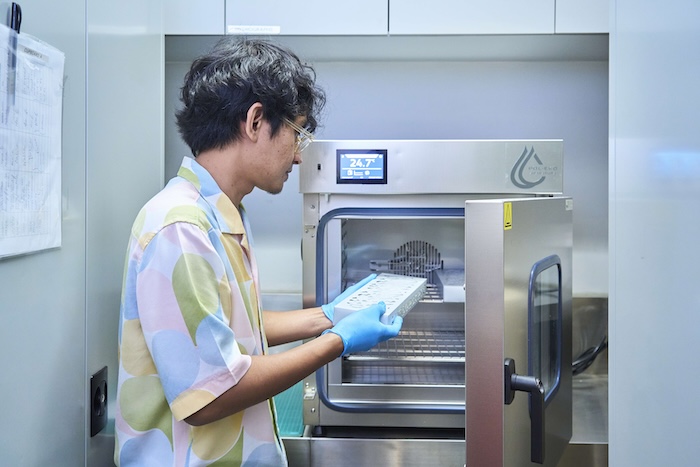
04. WHAT ARE SOME NEW TECHNOLOGIES OR MATERIALS EMPLOYED IN EXHIBITIONS IN RECENT YEARS?
Exhibition showcases have vastly improved in quality. One of the bugbears in exhibitions used to be the reflective surfaces of glass display cases, which tended to get in the way of visitors viewing the artefacts comfortably and clearly. These days, we use non-reflective glass for an optimal viewing experience. Similarly, we now have access to seamless large vertical glass panels which were not available before. In the past, the glass panels used for showcases had seams and joints that disrupted the visitor experience.
Thanks to hydraulics technology, these large glass panels and doors can now be opened and closed easily. The opening mechanism of showcases as well as their general aesthetics have also become a lot sleeker and more sophisticated. Gone are bulky parts and heavy hinges; these days, showcases can be opened with just the touch of a button.
Another development in showcase design is the installation of concealed projectors and speakers behind glass boxes. This enables us to project images and include sounds to create a more immersive experience for audiences. Static objects can now be augmented with interactive media to enhance their content.
These advancements in material engineering and technology have greatly expanded the possibilities in exhibition-making.
05. CAN YOU SHARE WITH US A MEMORABLE EXPERIENCE IN THE COURSE OF YOUR WORK?
In 2018, I carried out a ‘door-to-door’ courier service to return loaned artefacts to the Musée Guimet in Paris. The crated artefacts were statues from the ancient Burmese empire that had been displayed at ACM’s Angkor exhibition. As a courier I was responsible for the artefacts, so I had to make sure I was always physically present with them.
The journey spanned a total of 25 nerve-wracking hours! My day at ACM began at 5am when I loaded the artefacts onto the air-ride truck. This is a special vehicle that uses an air suspension mechanism to provide a smooth ride and minimise any abrupt movements to the priceless cargo. An hour later, I reached the airport. There, all 42 crates containing the artefacts were loaded securely onto the plane; throughout the trip, I never let the crates out of my sight.
It was not a straightforward journey to Paris as we were travelling on a cargo plane. There was a three-hour stopover at Sharjah in the United Arab Emirates where the plane collected more cargo. At this point, there were also horses being boarded onto the plane, accompanied by their breeders! While the breeders checked on their horses, I checked on my crates.
From Sharjah, it was another eight hours or so to London for another stopover. There, I checked on the crates again. At last, the plane landed at its final destination, Amsterdam Airport Schiphol, where all precious cargo was unloaded. Then it was a land transfer to Paris via another air-ride truck. Five hours later, I arrived at the Musée Guimet safely with the crates, finally concluding my 25-hour courier duty. It was only then that I was able to breathe again!
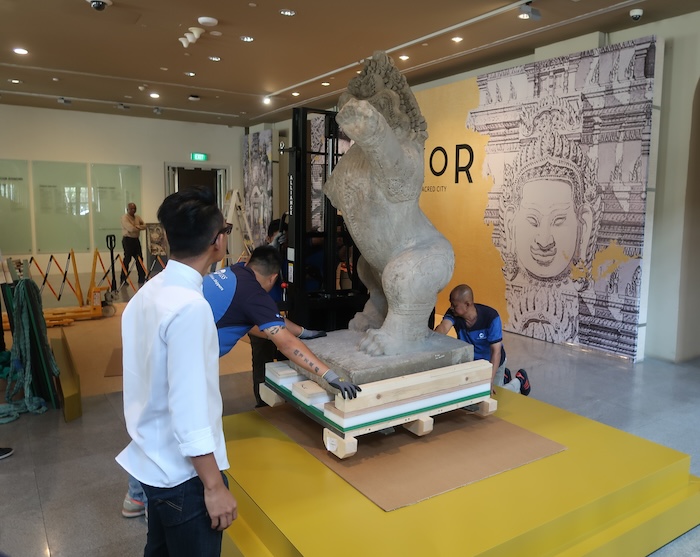
06. WHAT DO YOU ENJOY OR FIND MEANINGFUL ABOUT YOUR WORK?
Just as every exhibition is different, no two curators or conservators are the same. As an exhibition manager, I work very closely with a team of very talented people: curators, conservators, collection managers, exhibition designers and other specialists such as mounters, lighting technicians and art handlers. My job not only requires technical expertise, but also soft skills like people management.
As much as on-the-job training is important, it can never be sufficient. As the museum landscape is ever-evolving, I keep abreast of new advancements and technologies to discover new and innovative ways of doing things that would serve our audiences better.
An exhibition is a complex undertaking. Just mounting a single artefact is an intricate process that involves many painstaking hours. The microenvironment has to be just right for the artefacts to ‘live’. I often look at a showcase and wonder to myself, ‘Are the artefacts snug and comfortable in their new homes?’ And when I see a visitor admiring the artefact, I beam with pride. It’s an indescribable feeling!




